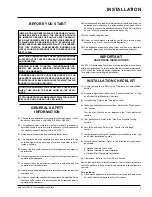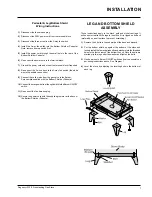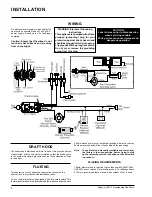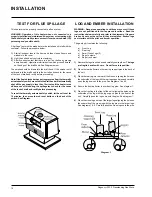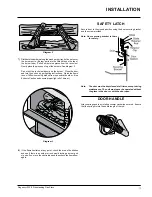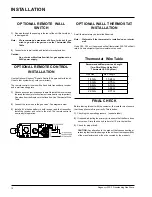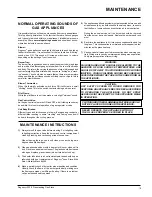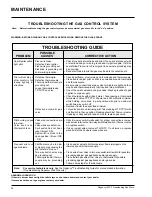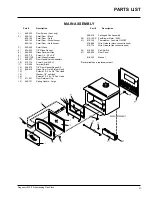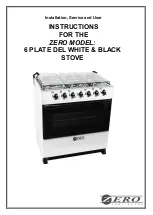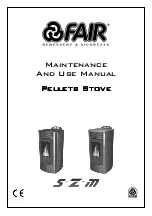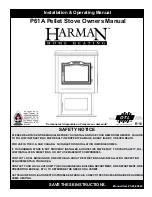
16
Regency
®
F33-3 Freestanding Gas Stove
Regency Freestanding Gas
GENERAL FLUE MAINTENANCE
Conduct an inspection of the flue system at least annually. Recom-
mended areas to inspect are:
1)
Check areas of the Flueing System which are exposed to the ele-
ments for corrosion. These will appear as rust spots or streaks, and
in extreme cases, holes. These components should be replaced
immediately.
2)
Remove the Cap, and shine a flashlight down the Flue. Remove
any birds nests, or other foreign material.
3)
Check for evidence of excessive condensation, such as water
droplets forming in the liner, and subsequently dripping out the
joints, Continuous condensation can cause corrosion of caps,
pipe, and fittings. It may be caused by having excessive lateral
runs, too many elbows, or exterior portions of the system being
exposed to cold weather.
4)
Inspect joints, to verify that no pipe sections or fittings have been
disturbed, and consequently loosened. Also check mechanical
supports such as Wall Straps for rigidity.
LOG REPLACEMENT
The unit should never be used with broken logs. Turn off the gas valve
and allow the unit to cool before opening door to carefully remove
the logs. The pilot light generates enough heat to burn someone. If
for any reason a log should need replacement, use only Regency
®
replacement logs. The position of these logs must be as shown in the
diagram under Log Installation.
NOTE: Improper positioning of logs may create
carbon build-up and will alter the unit’s performance
which is not covered under warranty.
GOLD-PLATED DOORS
The 24 carat gold plated finish on the door requires little maintenance,
and need only be cleaned with a damp cloth. DO NOT use abrasive
materials or chemical cleaners, as they may harm the finish and void the
warranty.
Clean any fingerprints off before turning the unit on.
GLASS REPLACEMENT
Your F33-3 stove is supplied with high temperature, 5 mm Neoceram
silica coated ceramic glass that will withstand the highest heat that your
unit will produce. In the event that you break your glass by impact,
purchase your replacement glass from an authorized Regency
®
dealer
only, and follow our step-by-step instructions for replacement.
1)
Allow the stove to cool before removing or replacing glass.
2)
To remove the door from the stove remove the securing screw lo-
cated between the ashlip and the door, then unfasten the latch.
3)
Remove gold hinge caps from door.
4)
Lift door off hinge and lay door on a soft, flat surface.
5)
Remove the screws in the glass retainer clips and remove the glass
retainer rod. Remove any remaining pieces of glass and ensure
that the door is free of debris. Use caution when removing broken
glass to avoid injury.
6)
Install the door screen (Australia only).
7)
Install the replacement glass. When placing the replacement glass
in the door, make sure that the glass gasketing will properly seal
your unit.
8)
Put glass in place and then position glass retainer rod.
Note: Do not use substitute materials. If your glass does
break, do not continue to use your unit until it has been
replaced.
9)
Position the glass retainer clips and door securing bracket. Secure
the glass retaining screws but do not overtighten as this may cause
the glass to break after the unit heats up.
10)
Tighten all screws evenly.
Do not overtighten as this may cause
breakage.
11)
Slip door over hinge pins and put hinge caps back onto door.
Latch
door securely using the handle and secure the security bracket
with the screw.
MAINTENANCE
NOTE: Door Screen only in Australia.
Handling of Ceramic fiber log sets and brick panels
When installing or removing ceramic fiber log sets or ceramic brick
panels (if installed) from an appliance we recommend that you use
latex gloves and a P1 respiratory filter be used.
We also recommend if when servicing the appliance that any items
which may be replaced, not be broken up and are sealed within a
heavy duty polythene bag and labeled as RCF waste.
A vacuum with a HEPA filter should be used when cleaning up remain-
ing dust or broken bits.
Protective clothing is not required when handling these articles.
RCF waste is classed as stable, nonhazardous waste which may be
disposed of at any licensed landfill site.




